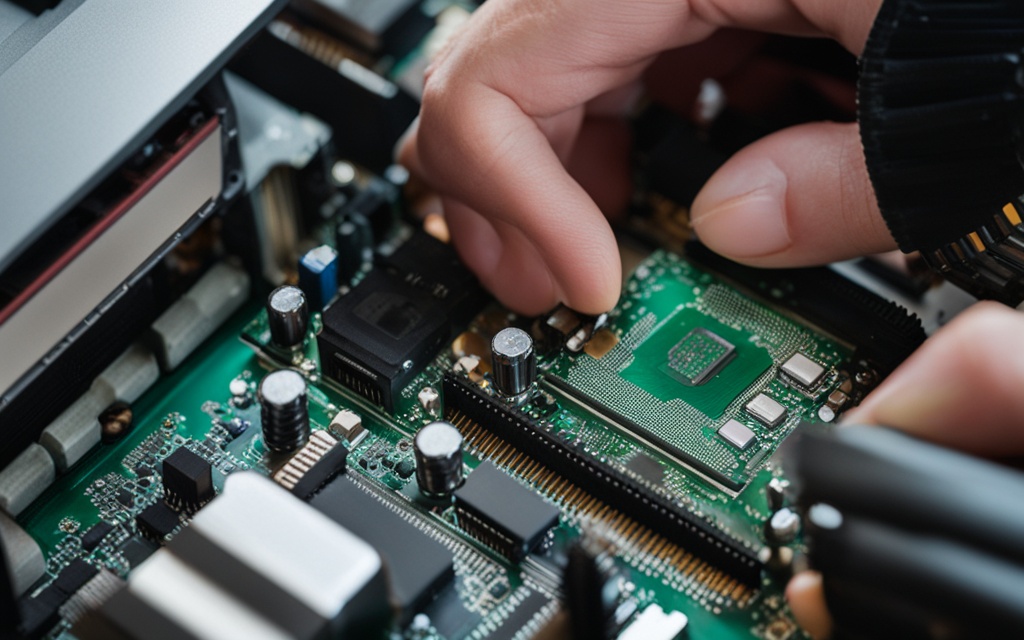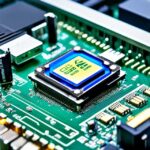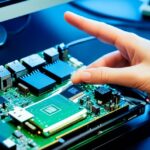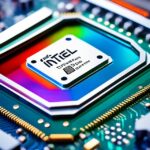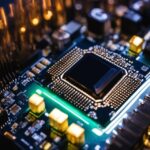Table of Contents
Updating your motherboard’s BIOS can seem daunting, especially with an older system. But, doing a BIOS Flashback with the CPU installed makes enhancing your computer’s hardware easier. This method allows for a seamless computer hardware update.
It ensures compatibility with new technologies, such as the AMD 5000 series processors. Some users, like those with MSI boards, have faced challenges. It’s important to understand BIOS Flashback’s workings for a smooth motherboard BIOS update process.
Getting to know its operation can ease the technical details. It also gives you control when dealing with possible glitches. For more insights, visit this forum to see how others have fared with BIOS Flashback on various boards1.
Key Takeaways
- BIOS Flashback allows users to update their motherboard’s BIOS without needing a fully functional CPU.
- Compatibility with new hardware can often be achieved by performing this update.
- Careful adherence to guidelines is essential for a successful BIOS update.
- Not all motherboards support the BIOS Flashback feature; verify your motherboard’s specifications beforehand.
- Professional help is advisable if problems arise during the updating process.
- For detailed processor comparisons, check the CPU hierarchy guide.
Understanding BIOS Flashback
BIOS Flashback is a helpful tool that lets users update their BIOS without needing a CPU, RAM, or graphics card. This feature makes updating the BIOS update process easier, especially when there are CPU compatibility issues. By using a USB flash drive with the right BIOS file, users can upgrade their systems effortlessly.
What is BIOS Flashback?
The idea behind BIOS Flashback is to offer an easy way to update. You just need a USB flash drive with at least 1GB of space and to press a button on the motherboard. This BIOS update mechanism lowers the risk of update failures that could stop your system from starting. It shows how important BIOS Flashback is.
When is BIOS Flashback Useful?
BIOS Flashback helps a lot after you’ve upgraded your hardware and the CPU isn’t supported by the current BIOS. It’s great for fixing boot failures or going back to default settings. BIOS Flashback makes updates smooth while keeping your system stable and fast.
How Does BIOS Flashback Work?
To use BIOS Flashback, you press a special button that tells the motherboard to update the BIOS. You must have the USB drive plugged in with the BIOS file and keep the power on. The motherboard spots the file and starts updating. This may last a few moments to 8 minutes. Users should watch for the FlashBack LED to flash three times, showing the update is done23. This method makes BIOS updates accurate and dependable without needing a CPU.
Can You Do BIOS Flashback with CPU Installed
BIOS Flashback offers great flexibility on many modern motherboards. It allows for updates without the need for changing much hardware. Having the CPU role in BIOS updates is crucial. It helps communicate between the motherboard and its components. Updating BIOS with the CPU in place makes things easier. It also significantly lowers the BIOS compatibility issues that come with mismatched hardware.
The Role of the CPU in BIOS Updates
The CPU connects the motherboard with peripheral devices during updates. While updates without a CPU are possible, having one installed boosts reliability. This feature is made to meet compatibility requirements. It ensures the latest BIOS works well with the CPU in use. BIOS Flashback is usually needed when updating for new hardware or making major changes1.
Are There Situations Where a CPU Is Required?
In certain cases, a CPU is needed for BIOS Flashback. This is especially true when the motherboard’s firmware needs specific instructions that only a working CPU can provide. When dealing with a CPU failure or incompatible versions, a functional CPU becomes crucial for BIOS Flashback4. It’s important for users to check their components carefully. To avoid issues, one should ensure BIOS file compatibility and have a reliable power source1.
Benefits of Using BIOS Flashback
BIOS Flashback offers lots of benefits that make using computers better and easier. It lets you update without taking parts out. This makes improving your motherboard easier and faster.
Convenience for Users
BIOS Flashback is great for its user convenience. It makes updating the BIOS easy, so you don’t have to take your system apart. Plus, Asus has made sure its BIOS Flashback is simple and stable to use, even with CPUs still in. You don’t need to remove anything.
5 It opens the door for anyone to update their BIOS easily. You don’t have to be a tech expert anymore.
Simplifying Troubleshooting
BIOS Flashback makes fixing problems easier, no matter what they are. If you can’t start your computer or it’s not working right, you can use this feature to fix it quickly. You don’t need to change much hardware.
It lets you go back to an older BIOS version to fix issues5. Updating your BIOS quickly helps your system run better and recover from problems fast.
Improved Compatibility with New Hardware
Keeping up with new technology is crucial. BIOS Flashback lets you update your system easily to work with new CPUs. You can find this feature in many motherboards from different brands67. Updating your BIOS often improves performance and keeps your computer running well.
| Feature | Benefit |
|---|---|
| User Convenience | Update without removing hardware components |
| Troubleshooting Made Easy | Swift resolutions to boot failures and system issues |
| Improved Compatibility | Updates to support new hardware effectively |
BIOS Flashback is key for modern computing. It makes things simpler and improves how we use computers6.
Motherboard Compatibility with BIOS Flashback
Understanding motherboard compatibility with BIOS Flashback is key before starting. Users should check their motherboard’s specs to see if it has this feature. Verifying specifications makes the update more likely to succeed.
Checking Motherboard Specifications
To check compatibility, look at the motherboard manual or visit the manufacturer’s website. Not every motherboard has the BIOS Flashback feature. It’s mostly on high-end models1. This feature is crucial for smooth updates and avoiding CPU and BIOS version issues1. Checking specs carefully avoids update problems.
Finding the BIOS Flashback Feature
Finding the BIOS Flashback feature requires more than manual checks. Look for labels like “USB BIOS Flashback”. Knowing these terms helps users better access the feature and make updates easier. To update successfully, direct access to the BIOS chip is needed, showing why manual checks matter1.
| Feature | Description | Importance |
|---|---|---|
| BIOS Flashback Support | Availability of the BIOS Flashback feature on motherboard | Essential for smooth updates |
| Specifications Verification | Checking compatibility details in manuals or websites | Prevents conflicts during the update process |
| Feature Accessibility | Labels or indicators for BIOS Flashback on the motherboard | Aids in quicker update procedures |
Updating BIOS with the CPU Installed
Updating the BIOS when the CPU is installed needs careful handling. Following the exact BIOS update instructions ensures a smooth update. First, download the latest BIOS version from the maker’s site. It’s important to check if it matches your motherboard’s model. After downloading, copy the file onto a USB drive. Then, shut down your computer and plug in the USB into the right port. Next, you must press a specific button combination to start the BIOS update mode. This approach helps the motherboard to update automatically, ensuring success8.
Step-by-Step Process
Here’s a straightforward guide to updating your BIOS:
- First, download the BIOS file that fits your motherboard.
- Then, copy it to a USB drive formatted in FAT32.
- Turn off your computer and connect the USB drive to the right port.
- Switch on the computer and press the correct keys to enter the update mode.
- Follow the instructions on the screen to finish the update.
This way works well, especially with the newest B550 and X570 motherboards that allow updating via USB9.
Preparing for the Update
To ensure a smooth BIOS update, preparation is key. Confirm the BIOS file downloaded correctly first. Also, make sure your power supply is reliable to avoid update interruptions. Returning any overclock settings to normal is wise too. Following these safe update tips makes the process secure and boosts your confidence3.
Common Issues When Performing BIOS Flashback
Trying to perform a BIOS Flashback can bring up several issues. These can make the update process complex. Understanding these issues helps in solving problems better. This makes a successful update more likely.
Compatibility Problems
Issues with BIOS Flashback compatibility are common, especially on older gear. It’s important to match the BIOS file with the motherboard correctly. Before you start, check the release notes for any known problems. Then, follow the solutions suggested to avoid these issues.
Power Supply Considerations
The power supply’s role in BIOS updates is crucial. A power cut during an update can corrupt the BIOS. This puts the system at risk. To avoid this, use a reliable power source or a UPS. This protects against power loss during the update.
Error Recovery Steps
If you hit snags during the update, recovering requires careful steps. Check that the BIOS file and USB stick are okay. If problems persist, the motherboard manual has tips for solving them. You might need to reset the CMOS or try the update again with the right BIOS file. This keeps the process stable. For tougher issues, getting help from the maker can be very useful81.
| Issue | Description | Solution |
|---|---|---|
| Compatibility problems | Conflicting BIOS files with outdated hardware | Verify BIOS file version against motherboard |
| Power supply interruptions | Power loss leading to BIOS corruption | Use a UPS for power stability |
| Error recovery | Failures during BIOS update procedure | Reset CMOS and check USB file integrity |
Manufacturer Guidelines and Support
Using the motherboard manual well is crucial when updating the BIOS. It has all you need to know about motherboard manual utilization. You’ll find step-by-step ways to update the BIOS, troubleshooting tips, and important safety advice. Knowing your way around these manuals boosts your confidence to handle problems.
Reading the Motherboard Manual
The motherboard manual is very important, especially to know the guidelines for BIOS update. There are sections for updates needed to work with new CPUs, like Intel’s 600 series or some AMD Ryzen types. Updates aren’t always needed; they’re suggested for issues or new hardware needs. Remember, a BIOS update might change your settings, so note them down before you start1011.
Contacting Support for Assistance
If you can’t fix a problem on your own, it’s important to contact manufacturer support. Many have special support lines, like manufacturer support contacts. ASUS, for example, tells you to reach out to their service centre if you’re stuck after an update. They show three ways to update the BIOS and help solve update issues. Quick contact with support can resolve issues fast and keep your computer running smoothly12.
Conclusion
Using BIOS Flashback with the CPU in place is more than just a tech perk. It marks a big step in making system updates easier and more beneficial. Knowing how BIOS Flashback works, what it needs to operate, and its advantages helps users tackle usual problems with ease. This technology simplifies updates, letting users fix bugs, tackle hardware issues, and boost performance while staying up-to-date with tech developments1314.
Thanks to top brands like ASRock, Asus, Gigabyte, and MSI, updating your BIOS is straightforward without needing a specific CPU or extra parts15. This makes upgrading smooth and ensures your computer keeps up with the demands of modern computing. So, in wrapping up our thoughts on BIOS updates, using BIOS Flashback really helps make your computer setup more future-ready.
Knowing how to update your BIOS properly, including using the right flash drives and following motherboard advice, helps avoid problems and improves your computer’s working. Keeping up with tech advances means staying informed and ready. This way, you can go through update processes knowing exactly what to do.,\p>
Q: Are there situations where a CPU is required for BIOS Flashback?
What is BIOS Flashback?
BIOS Flashback is a smart tool found on some modern motherboards. It updates the BIOS without needing a working CPU, RAM, or graphics card. With it, you can still update your motherboard even if the CPU doesn’t match.
When is BIOS Flashback Useful?
It’s great when you have trouble with new hardware, like CPUs not working right. BIOS Flashback lets you update the BIOS. This helps support new features or fix issues after adding or changing hardware.
How Does BIOS Flashback Work?
To use BIOS Flashback, you press a button on the motherboard. Then, you plug in a USB with the BIOS file. The motherboard will update itself without needing a CPU to work.
Can I perform BIOS Flashback with the CPU installed?
Yes, you can use BIOS Flashback even if there’s a CPU in the motherboard. It may even work better because it matches the new BIOS to the CPU, making things run smoothly.
What role does the CPU play during BIOS updates?
During a BIOS update, the CPU helps the motherboard talk to other parts. Even though you can update without it, having a CPU can make the update more reliable and lessen issues.
Sometimes, the motherboard needs the CPU for specific instructions for the new BIOS. If there’s a problem with the CPU or it didn’t work before, you might need it for the update to succeed.
What are the benefits of using BIOS Flashback?
BIOS Flashback makes updating easy without removing parts. It also helps quickly fix problems with starting the computer or when it’s not running right.
How can I check my motherboard’s compatibility with BIOS Flashback?
Check your motherboard’s manual or the maker’s website to see if it has BIOS Flashback. Make sure it fits the updates you want to do.
How do I find the BIOS Flashback feature on my motherboard?
Look for a label saying “USB BIOS Flashback” on your motherboard. You can also find info in the motherboard’s guide.
What is the step-by-step process for updating BIOS with the CPU installed?
First, get the newest BIOS file from the maker’s website and put it on a USB. Then, turn off the computer, plug in the USB, and use the right button combo to start the update.
What preparations should I make before a BIOS update?
Make sure the BIOS file is downloaded, have a good power source, and set any overclocking back to normal. Getting ready properly can prevent update troubles.
What common issues might arise when performing BIOS Flashback?
You might find compatibility troubles, especially with old parts or if the BIOS doesn’t match. Make sure the power won’t cut off and that the BIOS version and motherboard match up.
How can I recover from errors during a BIOS update?
Check the BIOS file and USB stick are okay. If you still have issues, look in your motherboard’s manual for help on fixing errors, like resetting the CMOS, or contact the maker.
Why is the motherboard manual important when performing BIOS updates?
The manual gives you important info on BIOS Flashback use, how to fix problems, and safety tips. It helps you confidently handle updates and issues.
How can I contact support if I encounter issues?
If you can’t fix a problem on your own, contact the maker’s support team. They have experts ready to help you with BIOS issues quickly.
Source Links
- https://softwareg.com.au/blogs/computer-hardware/can-you-use-bios-flashback-with-cpu-installed – Can You Use Bios Flashback With CPU Installed
- https://www.asus.com/us/support/faq/1038568/ – [Motherboard] How to use USB BIOS FlashBack™? | Official Support | ASUS USA
- https://www.easeus.com/backup-recovery/how-to-update-bios-without-cpu.html – In-depth Guide | How to Update BIOS Without CPU🔥
- https://softwareg.com.au/blogs/computer-hardware/can-you-q-flash-with-cpu-installed – Can You Q Flash With CPU Installed
- https://softwareg.com.au/blogs/computer-hardware/asus-bios-flashback-with-cpu-installed – Asus Bios Flashback With CPU Installed
- https://ms.codes/blogs/computer-hardware/can-you-use-bios-flashback-with-cpu-installed – Can You Use Bios Flashback With CPU Installed
- https://primetechsupport.com/blogs/gaming-pc-repairs/best-way-to-update-bios-all-you-need-to-know – Best Way To Update Bios – All You Need to Know
- https://rog-forum.asus.com/t5/hardware-build-advice/updating-bios-with-new-cpu-not-supported-bios-level/td-p/848309 – Updating BIOS with new CPU (Not supported BIOS level)
- https://glennsqlperformance.com/2020/11/09/flashing-your-bios-with-no-cpu-installed/ – Flashing Your BIOS with No CPU Installed – Glenn’s SQL Server Performance
- https://www.tomshardware.com/how-to/update-bios-on-a-pc – How to Update the BIOS on a PC: 3 Ways to Get New Firmware
- https://www.avg.com/en/signal/how-to-update-bios – How to Update BIOS on Your Windows PC
- https://www.asus.com/us/support/faq/1044348/ – [Motherboard] How to update BIOS of the motherboard ?(Include different generation CPU) | Official Support | ASUS USA
- https://www.cgdirector.com/update-bios-without-cpu/ – How to update your BIOS without a CPU
- https://www.hp.com/us-en/shop/tech-takes/how-to-update-bios-software – How to Update BIOS Software on Windows PCs | HP® Tech Takes
- https://www.toolify.ai/hardware/ultimate-guide-to-bios-updates-for-12th-13th-and-14th-gen-cpus-3246708 – Ultimate Guide to BIOS Updates for 12th, 13th, and 14th Gen CPUs

